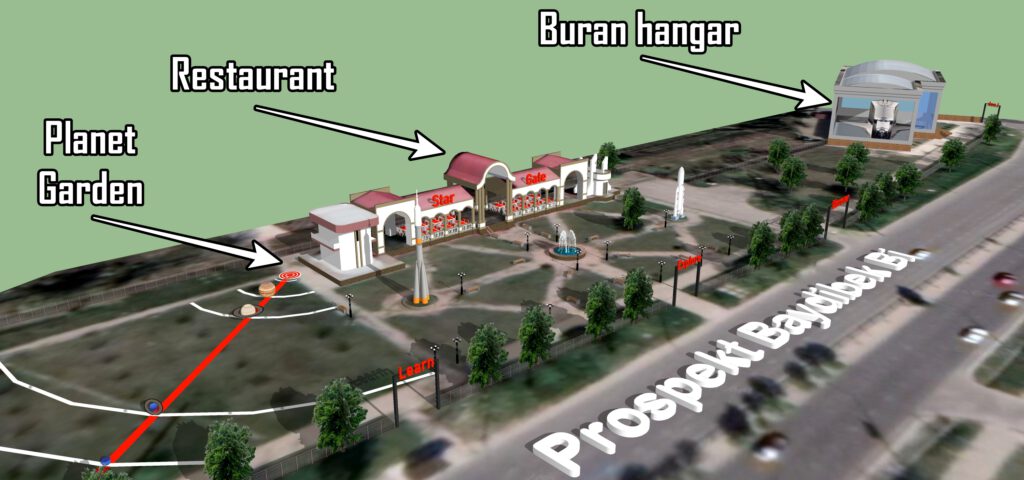35th anniversary of Buran flight: Time to find a home in a museum
We are calling to preserve the last two remaining flight models of Buran in a museum in Shymkent to protect them and make them more accessible.
Thirty-five years ago, on November 15, 1988, at 3:00 UTC, a distinctive spacecraft, the Buran, thundered into space from the Soviet Baikonur Cosmodrome with remarkable noise. Named after the Central Asian winter storm, the Soviet spacecraft was a response to the American Space Shuttle.
However, it was not merely a copy; rather, it was a technologically advanced version and ahead of time. In contrast to the Space Shuttle, the Buran already featured an autopilot, enabling autonomous launch and landing without a crew. This innovation eliminated the risk to human lives during the initial launch. Unlike the U.S. Space Shuttle, the Buran served as payload during launch, attached to one of the world’s most powerful liquid-fueled rockets, the Energia. In any emergency during launch, the Energia could be shut down, allowing the Buran to detach and land safely. This safety feature was absent in the U.S. shuttle, as its rocket engines were at the rear of the spacecraft, with fuel stored in a massive orange external tank. Additionally, it had two solid rocket boosters on either side, which could not be shut down after ignition—a design flaw highlighted by the Challenger disaster in 1986.
Despite the Buran’s promising advantages, the dissolution of the Soviet Union led to financial difficulties, resulting in the cessation of the program in 1993 after no further flights. The only flown Buran, Version 1.01, was housed in MIK-112. Tragically, on May 21, 2002, the dilapidated roof collapsed, claiming eight lives, and completely destroying the Buran prototype. However, two other Burans, built for space flights but left unfinished, remain in Kazakhstan’s possession in the MZK building 80, attracting media attention from outlets such as CNN, New York Post, Daily Mail, Telegraph, Der Spiegel, Stern, GEO, National Geographic, and WIRED Magazine who reporting on the decay of these incredible machines. And we believe they will report again about it on the 35th anniversary and will shake heads why nobody is taking care about it and why these Soviet space shuttles are not moved into a museum.

On the 35th anniversary of the maiden flight, we call persist for these technological wonders to be preserved in a museum rather than left to decay. After long 35 years in a bad wet and dusty environment, it is time to retrieve the remaining two Burans from their storage.
Currently the two space orbiter are owned by Kazakh company RSC Baikonur JSC and the owner of this company is the Kazakh entrepreneur Dauren Mussa. But the Kazakh state demands these space shuttles to return to state ownership. Prolonged disagreements would not benefit these Soviet space shuttles or prevent their deterioration. Cooperation between the parties is crucial to preserving these historical artifacts for future generations.
Displaying the Buran in an accessible location, such as the bustling city of Kazakhstans 3rd largest city Shymkent, would attract numerous visitors. Given the global awareness of the Soviet space shuttle’s fate, transporting it to a museum would generate significant media coverage and draw international visitors. We propose bringing at least one Buran from the Baikonur facility to Shymkent via train or heavy transport.
The former Children’s Railway station, situated between Dendropark and the Zoo on Prospekt Baydibek Bi, would be an excellent new home. Integrating the future space museum into the surroundings of Dendropark, the zoo, the Regional Museum of History, and the Zhailaukol amusement park would create a compelling attraction for Shymkent’s residents.
The current land of the former train station is owned by the municipally owned company GU “Energy Management & Communal Economy in Shymkent”, providing the city of Shymkent an opportunity to re-purpose it for a museum. This initiative could add another landmark to the city, enhancing its recognition beyond national borders.
Let’s save the Buran and finally provide it with a secure home, making this spacecraft accessible to the public as a beacon of inspiration for all who seek to explore the realms beyond our planet.
We urge our readers to share this article to encourage the mentioned individuals and institutions to move the Soviet spacecraft to a future museum in Shymkent. We are ready to push this idea further and we are ready to help where we can.
Many thanks for your support everyone!


Article Photo: Buran at the launch pad in Baikonure Cosmodrome before its first and only flight. Photo is a free-to-use photo from The Energia-Buran Archive.



